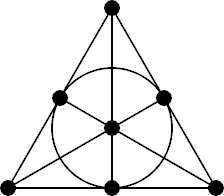Finite geometry
|
|
A finite geometry is any geometric system that has only a finite number of points. Euclidean geometry, for example, is not finite, because a Euclidean line contains infinitely many points, in fact precisely the same number of points as there are real numbers. There are two main kinds of finite geometry: affine and projective. In an affine geometry, the parallel postulate holds, meaning that the normal sense of parallel lines applies. In a projective geometry, by contrast, any two lines intersect at a unique point, and so parallel lines do not exist. Both finite affine geometry and finite projective geometry may be described by fairly simple axioms.
For affine geometry, the axioms are as follows:
- Given any two distinct points, there is exactly one line that includes both points.
- The parallel postulate: Given a line L and a point P not on L, there exists exactly one line through P that is parallel to L.
- There exists a set of four points, no three collinear.
The last axiom ensures that the geometry is not empty, while the first two specify the nature of the geometry. The simplest affine plane contains only four points; it is called the affine plane of order 2. Since no three are collinear, any pair of points determines a unique line, and so this plane contains six lines. More generally, a finite affine plane of order n has n2 points and n2 + n lines; each line contains n points, and each point is on n + 1 lines.
(Figures of affine planes of orders 2 and 3 to be added.)
The axioms of projective geometry are:
- Two distinct points lie on exactly one line.
- Two distinct lines intersect at exactly one point.
- There exists a set of four points, no three collinear.
 Diagram of the Fano plane |
An examination of the first two axioms shows that they are nearly identical, except that the roles of points and lines have been interchanged. This establishes the principle of duality for projective geometry, meaning that any true statement about the geometry remains true if we exchange points for lines and lines for points. While the third axiom only requires the existence of four points, the plane must contain at least seven points in order to satisfy the first two axioms. In this simplest of the projective planes, there are also seven lines; each point is on three lines, and each line contains three points. This particular projective plane is sometimes called the Fano plane. If any of the lines is removed from the plane, along with the points on that line, the resulting geometry is the affine plane of order 2. For this reason, the Fano plane is called the projective plane of order 2. In general, the projective plane of order n has n2 + n + 1 points and the same number of lines (respecting duality); each line contains n + 1 points, and each point is on n + 1 lines.
It is well-established that both affine and projective planes of order n exist when n is a prime power, a prime number raised to a positive integer exponent. It is conjectured that no finite planes exist with orders that are not prime powers, although this statement has not been proved. The best result to date is the Bruck-Ryser theorem, which states: If n is a positive integer of the form 4k + 1 or 4k + 2 and n is not equal to the sum of two integer squares, then n does not occur as the order of a finite plane. The smallest integer that is not a prime power and not covered by the Bruck-Ryser theorem is 10; 10 is of the form 4k + 2, but it is equal to the sum of squares 12 + 32. Using sophisticated techniques and computer analysis, it has been shown that 10 is also not the order of a finite plane. The next smallest number to consider is 12, for which neither a positive nor a negative result has been proved.
